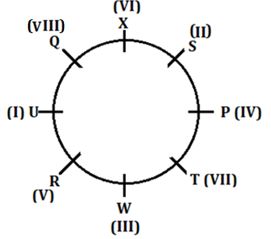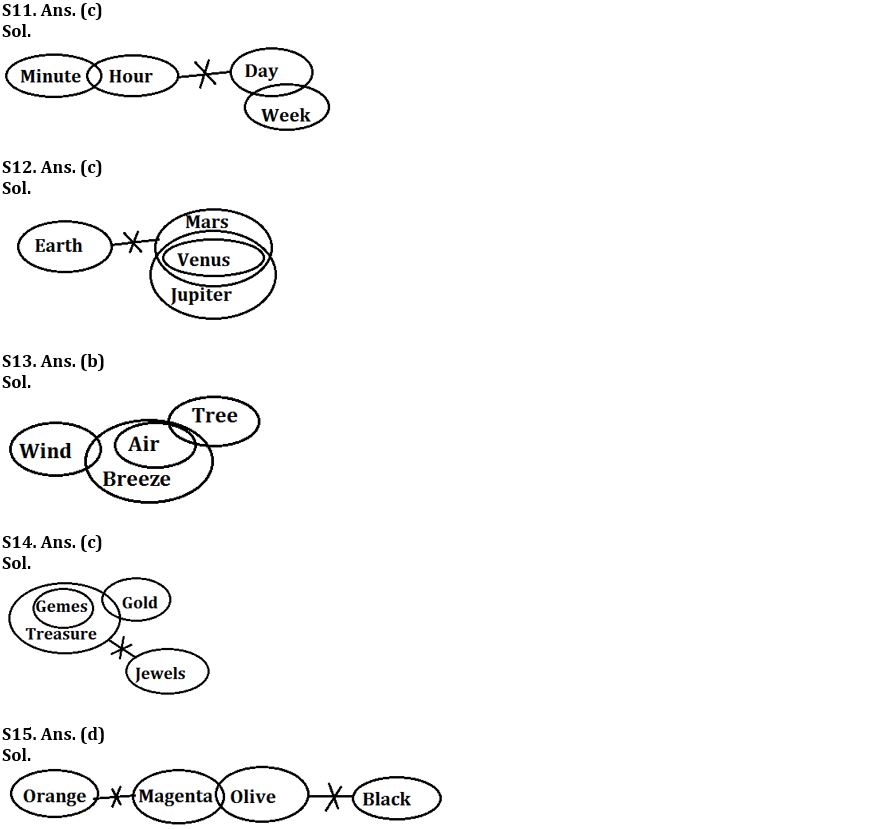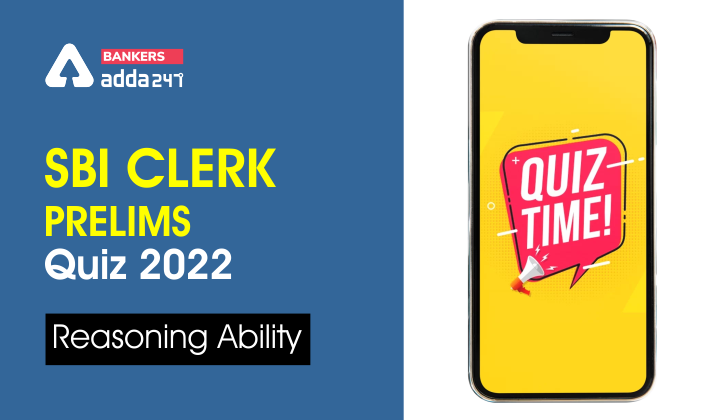Directions (1-5): Study the following information to answer the given questions:
Eight students P, Q, R, S, T, U, W and X are sitting in a circular table. All of them face towards the center. Each of them studies in different Std. i.e. I, II, III, IV, V, VI, VII and VIII but not necessarily in the same order.
Three persons sits between P and U, who study in I. S sits third to the right of W. The one who study in IV sits second to the right of W. Three persons sit between the one who study in VI and the one who study in III.R sits second to the left of T, who sits third to the left of person who study in VI. The one who study in VIII sits second to the right of S. The one who study in VII sits second to the left of the one who study in II std. Q does not study in VI std. R does not study in VII std. T does not face W.
Q1. Who among the following person sits immediate right of W?
(a) Q
(b) S
(c) R
(d) P
(e) None of these
Q2. Who among the following person study in VII std.?
(a) R
(b) T
(c) P
(d) V
(e) None of these
Q3. How many persons sit between W and Q when counted to the right of W?
(a) Two
(b) One
(c) Three
(d) More than three
(e) None
Q4. Who among the following person sits second to the right of P?
(a) S
(b) X
(c) Q
(d) P
(e) None of these
Q5. Which of the following combination is true?
(a) P-IV
(b) U-II
(c) X-VII
(d) R-II
(e) None of these
Directions (6-10): In these questions, relationship between different elements is shown in the statements. These statements are followed by two conclusions. Mark your answer as-
(a) if only conclusion I is true.
(b) if only conclusion II is true.
(c) if either conclusion I or II is true.
(d) if neither conclusion I nor II is true.
(e) if both conclusion I and II are true.
Q6. Statements: M>O, S≤U, T≥P=R, O≤T=S
Conclusions: I. O≥R
II. U≥R
Q7. Statements: E>G≤D, E≥C=V, H≥D
Conclusions: I. C≤H
II. G≤H
Q8. Statements: X>V≥W, R>V=S
Conclusions: I. X<W
II. R>W
Q9. Statements: P>K=L, P≤S<Q, T>K
Conclusions: I. Q>K
II. Q<T
Q10. Statements: G<H, K≥M>H, N≥K
Conclusions: I. N≥G
II. M>G
Directions (11-5): In each of the questions below some statements are given followed by some Conclusions. You have to take the given statements to be true even if they seem to be at variance from commonly known facts. Read all the Conclusions and then decide which of the given Conclusions logically follows from the given statements disregarding commonly known facts.
Q11. Statements: A few minute are hour.
No hour are days.
Atleast days are week.
Conclusions: I. Some day is minute is a possibility
II. Some week is not hour
III. No day is week
(a) Only I follows
(b) Only II follows
(c) Only I and II follow
(d) Only III follows
(e) None follows
Q12. Statements: No Earth is a Mars.
All Venus are Mars.
All Venus are Jupiter.
Conclusions: I. At least some Jupiter are not Earth.
II. No Earth is Jupiter
III. No Venus is a Earth.
(a) Only I follows
(b) Only II and III follow
(c) Only I and III follow
(d) Only I and II follow
(e) None of these
Q13. Statements: Only a few wind are breeze.
Some air is tree.
All air are breeze.
Conclusions: I. All wind is air is a possibility.
II. All breeze is wind is a possibility.
III. Some tree is breeze is a possibility.
(a) Only I follows
(b) Only II follows
(c) Only III follows
(d) Only II and III follow
(e) None of these
Q14. Statements: Only treasure are gems.
Only a few treasure is gold.
No treasure is jewel.
Conclusions: I. All treasure are gold is a possibility.
II. All jewels are gold
III. No gems is jewels.
(a) Only I follows
(b) Only II follows
(c) Only III follows
(d) Only I and II follow
(e) None of these
Q15. Statements: Only a few Magenta are Olive.
No Magenta is Orange.
No Black are Olive.
Conclusions: I. Some Black are Orange is a possibility.
II. All Magenta is olive is a possibility.
III. Some magenta is black.
(a) Only I and III follow
(b) Only II follows
(c) Only II and either I or III follow
(d) Only I follows
(e) None of these
Solutions
Direction (1-5):
Sol.

S1. Ans. (e)
S2. Ans. (b)
S3. Ans. (d)
S4. Ans. (b)
S5. Ans. (a)
S6. Ans. (b)
Sol. I. O≥R (false)
II. U≥R (true)
S7. Ans. (b)
Sol. I. C≤H (false)
II. G≤H (true)
S8. Ans. (b)
Sol. I. X<W (false)
II. R>W (true)
S9. Ans. (a)
Sol. I. Q>K (true)
II. Q<T (false)
S10. Ans. (b)
Sol. I. N≥G (false)
II. M>G (true)






 GA Capsule for SBI Clerk Mains 2025, Dow...
GA Capsule for SBI Clerk Mains 2025, Dow...
 The Hindu Review October 2022: Download ...
The Hindu Review October 2022: Download ...
 IBPS PO Syllabus 2025 and Exam Pattern f...
IBPS PO Syllabus 2025 and Exam Pattern f...







